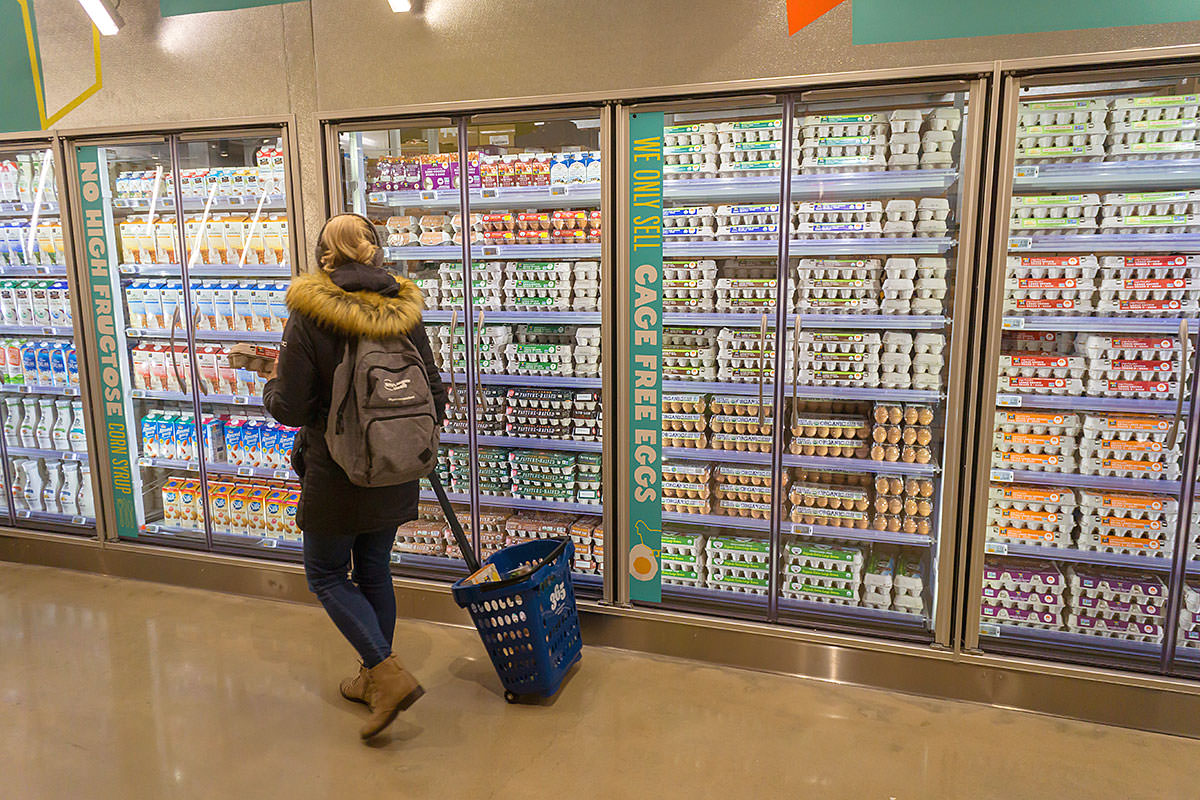Inflation has reached its highest level in 40 years—7 percent in 2021 and still rising. Concurrently, President Biden’s approval rating has dropped from 53 percent on Inauguration Day to 40 percent in late February before Russia invaded Ukraine. (By late March, it was 42 percent, and it has remained at this level through the first half of April.)
Higher inflation is not the only reason for the president’s declining popularity. The resurgent coronavirus has hurt. So has failing to pass Build Back Better, Biden’s signature economic plan. For voters, however, inflation is the primary concern. A January CBS-YouGov poll gave the president his worst results on inflation: 58 percent of those surveyed blame Biden for the problem.
This raises two questions—why is inflation rising, and what can the president do about it?
Inflation measures the price change for goods and services bought by a typical family. An annual inflation rate of 7 percent means that people are forking over 7 percent more money to buy the same things they bought a year ago; or they can buy 7 percent less, this year, with last year’s income.
But incomes are not fixed. Wages rose 4.7 percent in 2021; with 7 percent inflation, an average wage was able to purchase 2.3 percent less at the end of 2021, as compared to the end of 2020.
Income is also more than just wages. Two legislative bills boosted 2021 incomes. In late December 2020, President Trump signed a $900 billion Covid relief act, providing $600-per-person stimulus checks, among other things. In March 2021, President Biden signed the $1.9 trillion American Rescue Plan, sending $1,400 checks to most Americans. It also provided families with six child tax credit payments of $250 or $300 per child (see my July 2021 article in The Washington Spectator).
For a median earner (making around $52,000), the two checks totaling $2,000 more than countered the lost purchasing power of wages due to inflation. The child tax credit ensured that families with children came out significantly ahead.
Yet Republicans talk of “Bidenflation,” conveniently ignoring President Trump’s Covid relief bill, as well as the fact that most Americans were better off in 2021 than in 2020. Many recite talking points that U.S. inflation exceeds that of other developed countries. While this claim is true, the difference has not been that great. Inflation in the European Union was 5 percent last year. In the U.K., it was 5.4 percent; in Canada 4.8 percent. None of these nations employed the aggressive Covid relief policies that we did. Inflation was around 2 percent in the United States and most other developed nations before 2021. Of the five-percentage-point rise in American inflation last year, we can attribute two points to U.S. policies; the other three points stem from global forces.
It’s worth noting that the trade sanctions imposed on Russia following its invasion of Ukraine at the end of February 2022 have led to converging inflation rates throughout the developed world, as Russia’s main export—energy—has become the most significant inflationary pressure in the world economy.
For 2021, the higher U.S. inflation, compared to other developed nations’, was due to U.S. policies that resulted in more spending. But these policies also created more jobs. Unemployment in the United States was 3.8 percent in February 2022, much lower than the 6.2 percent in Europe. The lower unemployment rate in the United States gave us four million additional jobs but also two percentage points of higher inflation.
Still, no one likes inflation. Workers believe they deserve their higher pay and that inflation robs them of their hard-earned gains. There is also a political cost to inflation—everyone suffers from inflation, while only a small fraction of the population experiences unemployment. This is why the president’s approval rating has fallen and why inflation understandably worries Democrats.
I remain skeptical that we face a future of rising inflation.
As noted earlier, the government put a good deal of money into the hands of households in 2021. These inflationary pressures have abated. The last stimulus checks went out a year ago. Expanded unemployment benefits ended last September. And the Federal Reserve began raising interest rates in March; it plans to continue raising rates throughout 2022. All this will reduce spending and exert downward pressure on prices.
This still leaves several global supply problems (which were responsible for more than half the increase in inflation in the United States last year), a health pandemic, higher energy prices, and climate change.
The coronavirus has created labor shortages. Some people retired sooner due to Covid fears. Some adults face Covid-related health problems or childcare needs that reduce their ability to work. With fewer workers, wages will rise and higher production costs will get passed on to consumers as higher prices. Two labor shortages in the United States are noteworthy, as they impact the price of many goods. Due to retirement, high quit rates, and industry growth, the United States is short 90,000 truckers. Trucks move 72 percent of parts to producers and goods to consumers. Longshoremen, who unload goods shipped from abroad, are also in short supply, leading to transportation delays, shortages of goods, and higher prices.
Rising oil prices have a number of different causes, including Russia’s invasion of Ukraine and people choosing to drive rather than take mass transportation because of Covid-19 concerns. Russian oil, which provided 10 percent of the world’s oil supply, is now largely off the world market. Another huge factor is OPEC output restrictions, which have reduced the global supply of oil by nearly three million barrels a day compared to pre-pandemic levels. Less oil production means higher energy and gas prices, which then impact the cost of transporting parts to manufacturers and finished goods to markets.
A final problem stems from climate change. Problems producing computer chips have contributed to the increased prices of cars, appliances, and many other goods requiring chips. Taiwan, which manufacturers 90 percent of advanced chips, still has a drought problem that experts attribute to climate change (see my article in the July/August 2021 Washington Spectator). This is a problem for chip production, which requires large quantities of water, and Taiwan has been rationing. The good news is that this situation has been improving recently.
Lumber is another example of how climate problems impact overall inflation. Most lumber that is used to build American homes comes from British Columbia, where the cold weather strengthens trees. Over several years, climate-related fires have destroyed forests in British Columbia, and the mountain pine beetle has destroyed additional trees as more beetles survive warmer winters. U.S. building codes require strong lumber that will bend but not break. Lacking this lumber, over the past decade new housing construction is down around six million units (relative to new household formation), according to the National Association of Realtors. Along with the Covid-related demand for more space by people working from home, home prices have soared. This price rise reverberates through the entire housing market, as people who can’t buy homes must rent, causing rents to rise.
In the months ahead, higher interest rates and the end of Covid relief policies should lead to reduced U.S. inflation. Also, Covid-induced inflation will fall as the worldwide coronavirus pandemic wanes. When this will occur remains uncertain.
The Biden administration has made a good start dealing with supply-side inflationary pressures. It has encouraged ports to maintain longer hours to reduce transportation costs for goods entering the United States from abroad and has reduced waiting times to obtain a truck driver’s license. In November, the president released oil from the strategic petroleum reserve in order to constrain gas price increases. In March, he announced that more oil would be released from U.S. reserves to counter the loss of oil from Russia and that he had persuaded other nations to release oil from their reserves. In April, President Biden announced that gasoline could be sold with a higher ethanol content, which should cut the cost of a gallon of gasoline by 10 cents.
Still, the Biden administration can and should do more. Eliminating the Trump tariffs (which the president can do without Congress) and other tariffs (President Biden, for example, has increased the Trump tariffs on Canadian lumber) would lower the cost of imports. Reducing other trade restrictions, except for sanctions on Russia (which sells little to the United States besides oil), would increase competition and lower prices. Since housing is such a large part of consumer expenditures, a temporary limit on rent increases would help reduce overall inflation, as would the elimination of tariffs on Canadian lumber.
Also, Democrats can push legislation allowing Medicare to negotiate prescription drug prices, something supported by more than 80 percent of the public and contained in the Build Back Better bill passed by the House of Representatives last year. The president should channel his inner Harry Truman and dare Senate Republicans to filibuster this. Finally, the president could announce a temporary holiday on the gas tax (currently 18.4 cents a gallon) as some Democrats have suggested. One downside of this last policy prescription is that it would contribute to the climate problems noted above that are contributing to rising prices.
Regrettably, these initiatives will have only a small impact on inflation. Much of the global supply-side inflation is beyond the power of the president to control and, as noted above, several forces will push inflation down in the months ahead without any action from the White House. Still, the president needs to pursue what he can to defeat inflationary pressures. Just as he has been blamed for rising inflation, the president will want to be able to take credit for falling inflation come November.
Steven Pressman is professor emeritus of economics and finance at Monmouth University and author of Fifty Major Economists, 3rd edition (Routledge, 2013).




0 Comments